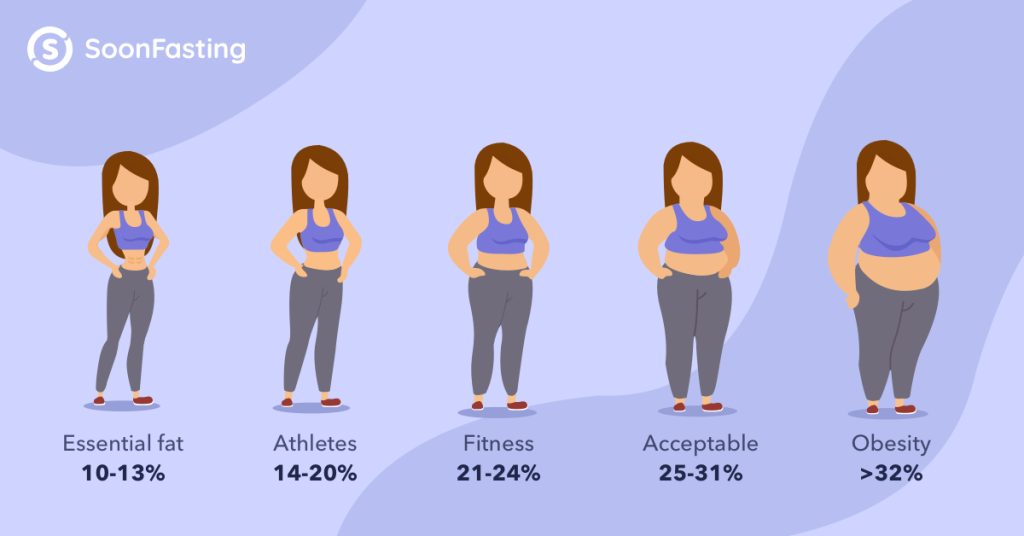Each person has a unique body shape, just like each snowflake is unique. It is possible for someone to look completely different even though they are the same height and weight. In some regions, compared to the next person, we have more mass due to our DNA, whereas in other places, we have less mass. Genetics plays a major role. Others can have long legs, while some are endowed with enormous arms. Body shape, however, is greatly influenced by body fat proportion as well.

How Much Body Fat is On Me?
The body fat percentage is the only factor that matters when judging how slim or how much additional fat a person is carrying. Although there are several ways to measure body fat, if the statistics are precise, they will show you how much fat you are currently carrying.
For example, if you weigh 200 pounds and your body fat percentage is 20 percent, you have 40 pounds of fat on your frame. Don’t be too hard on yourself if you test a little high because even professional athletes rarely test under ten percent body fat.
Body fat in men typically ranges from 18 to 24 percent. Women typically score higher, between 25 and 30 percent, because they typically have some excess body fat in all the right places. The majority of male body fat collects around the stomach. It could be on a woman’s tummy, legs, breasts, or buttocks.
In any case, even if we all weigh the same, our body fat % is undoubtedly one of the key reasons we don’t all look the same, and it is simple to calculate using a body fat percentage formula. Someone may be 50% muscled whereas the individual next to them may be significantly higher at 70% muscle mass. The person will appear leaner and more developed with a higher muscle mass percentage. A person is less likely to have any discernible definition the higher their body fat percentage.
What Exercises Should You Do to Lose Body Fat and Get Your Figure Back?
This is, without a doubt, a crucial topic. What physical activities can you do to reduce your body fat? An excellent choice, to begin with, is cardio. Your muscle mass will increase as a result of strength training, and muscle continues to burn calories and fat even when at rest. But starting in the kitchen is the secret to losing a significant amount of body fat. You should consume fewer calories, less junk food, and more nutrient-dense foods. Eat like a caveman and keep it straightforward. water, meat, veggies, and fruits. If you maintain a sensible eating pattern like this, your body fat percentage may decrease by double digits.
In addition, high-intensity interval training (HIIT) is a high-intensity exercise technique that uses quick bursts of effort interspersed with brief rest periods to keep your heart rate up. It has been demonstrated to promote fat reduction and burns more calories in less time than other forms of exercise.
According to one study, HIIT burns up to 30% more calories than other forms of cardio over the course of the same period of time.
What Else Can You Do to Manage Your Weight and Body Fat?
Check your body fat every few months
If you can track your progress with a decent weight loss regimen, you’ll stick with it more frequently. Get your body fat percentage evaluated every other month if you wish to lose body fat. It is acceptable to periodically check the scale as well throughout this time. Just remember not to become discouraged if the scale doesn’t show significant weight loss. After all, you might be gaining pounds of muscle while also reducing pounds of fat.
Eat good fats
Focus on eating healthy “good” fats like polyunsaturated fats and reducing damaging “bad” fats like trans fats rather than following a low-fat diet. Consume fish, avocados, olives and olive oil, eggs, nuts and nut butter, seeds, dark chocolate, and other foods high in heart-healthy monounsaturated and polyunsaturated fats. Trans fats, which are present in fried foods, vegetable shortening, margarine, baked products, and processed snack items, should be avoided in the interim.
Get enough sleep
According to research, persons who sleep for fewer than seven hours in a 24-hour period are more likely to be obese than those who routinely receive at least seven hours. Weight loss and muscle building depend on getting enough sleep. Feel free to use your aim to reduce your body fat percentage as a justification for getting to bed earlier because the average adult only gets six hours of sleep or fewer. Sleeping off the pounds is the simplest approach to reducing weight.
Slow down and enjoy your food
The typical person’s gastrointestinal tract begins alerting the brain that it is full about 20 minutes after eating. In order to prevent unintentional overeating, take your time, eat slowly, and enjoy your meal as you go. By doing this, you give your stomach the time and space to signal your brain when you’ve had enough to eat.
References:
